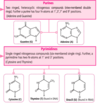CH6n DNA and Biotechnology Flashcards
DNA
- Nucleosides
- Nucleotides
name the bases, which one is only in RNA/DNA
Purines and pyrimidines? heaviest base?
who pairs with who and how many H-bonds
- Nucleosides: 5-carbon sugar (pentose) bonded to a nitrogenous base and are formed by covalently linking the base to C-1 of the sugar i.e Adenosine and Deoxythymidine
- Nucleotides: Are formed when one or more phosphate groups are attached to C-5 of a nucleoside. They are named based on the # of phosphates (AMP, ADP, ATP)
A-T (2 H-bonds)
G-C (3 H-bonds)
G is the heaviest

DNA directionality
Is read from where to where?
type of bonds
Is read from 5’ to 3’
Adds nucleotides from 5’ to 3’ direction
linked by phosphodiester bonds b/w 3’ carbon of a sugar to the 5’ phosphate group of the next sugar
Phosphate is at 5’
Hydroxyl group (OH) is at 3’
DNA, Histones, Nucleosome, and Chromatin
Heterochromatin vs Euchromatin
Telomers and Centromeres
DNA is wrapped around Histones, which form a nucleosome complex and all of this is called chromatin and the chromosomes
Heterochromatin (dark and dense, compact parts that is not transcribed)
Euchromatin (light uncondensed and is expressed)
Telomers: region of repetitive nucleotide sequences at each end of a chromosome, which protects the end of the chromosome from deterioration or from fusion with neighboring chromosomes.
Centrosome: Made of heterochromatin and holds sister chromatids together
DNA replication
- Helicase
- DNA polymerase
DNA replication
DNA polymerase is the only process that reads from 3’ to 5’, adding pairs
- Helicase: enzyme unwinds DNA generating two strands
- DNA polymerase: reads DNA template and synthesizes new daughter strand
DNA repair mechanism:

PCR vs Southern plot
PCR: copies of DNA fragments. separates a DNA strand by heat, a primer is added with a polymerase to replicate that strands, and the process is repeated
Southern: searches for a particular DNA sequence

